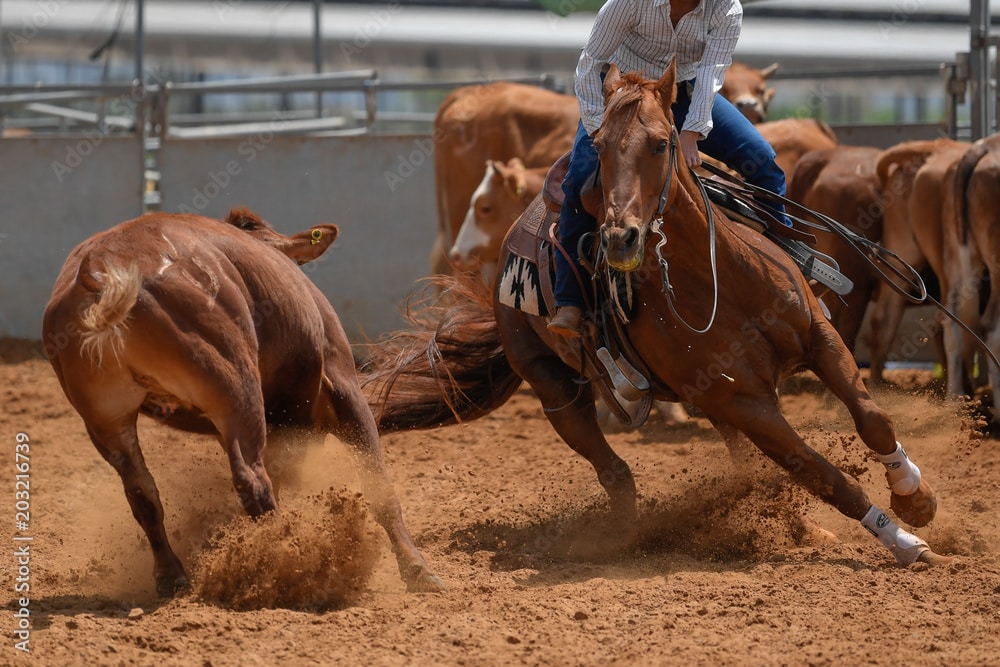American equitation, also known as western riding, originated in the western United States in the 19th century as a way of working cattle. As the cowboys did not have access to the sophisticated means of transport we know today, the movement and handling of the herds was done on horseback. From this essential need came several equestrian disciplines that have evolved over time.
The main disciplines of western riding are cow work, gymkhana, dry work and ground work.
Livestock work
In this equestrian discipline, the rider and horse pair must perform exercises to lead the cattle. The most notorious test is the “cutting”, where the rider and his horse must separate a calf from the herd and prevent it from joining the herd. The horse’s instinct plays a big part in this, as it has to anticipate all the cattle’s movements. With the help of 4 other riders (called “helpers”), the cowboy has exactly 2.5 minutes to separate 2 calves from the herd. The rider’s control and good balance are essential to help his horse be as reactive as possible in this exercise.
This event can also be performed by 3 riders (this is called “team penning”): 3 calves are separated from the herd, and 3 cowboys have to get them back to their pen within a given time. This event requires an extraordinary sense of teamwork on the part of the riders.
Speed events
By far the most spectacular, speed events are very popular in Western riding. One of the best known events is barrel racing, which consists of riding as fast as possible between three oil barrels arranged in a triangle. The course, in the shape of a three-leaf clover, can be ridden clockwise or anti-clockwise, depending on the horse’s footing preference. The best times recorded are between 13 and 16 seconds (depending on the spacing of the barrels).
Mounted work in American equitation
Riding is an equestrian discipline that is similar to dressage in classical riding. The couple, formed by the rider and his horse, must perform figures (patterns) and exercises in a calm manner.
Reining is probably the best known event in Western riding, so much so that it is recognised by the FEI (International Equestrian Federation) and represented at the World Equestrian Games. Among the different figures of “reining”, we find the famous “sliding stop” where the horse launched at full gallop stops quickly by sliding on its hindquarters, the “spin” where the horse links a series of pirouettes on the hindquarters at high speed, or the “roll back”, a real half-turn at a gallop on the hips.
In reining, cowboys hold their reins in only one hand. Starting with a total of 70 points, each rider is awarded penalties or bonus points during his or her reining, depending on the success of the tricks.
Another key event in Western riding, the trail consists of a series of obstacles that could be found in the natural environment, such as gates to be opened and closed, the passage of successive tree trunks, etc. The obstacles must be fixed and not exceed 45 cm in height, as it is the agility of the horse that is scored and not its power. The obstacles must be fixed and not exceed 45 cm, as it is the agility of the horse that is scored and not its power.
Work in hand in American equitation
The main event in this equestrian discipline is the “showmanship”. In this event, the rider presents his horse in hand to a jury. Only the rider’s qualities are judged in this exercise.
What feed for American riding horses?
Western riding is very physical for horses as it requires a lot of reactivity, fast changes of pace, physical movements and a lot of balance. This requires proper nutrition to provide the horse’s muscles with the energy they need to function properly. If you ride Western horses on an occasional basis or at a beginner’s level, Royal Horse Type S feeds are well suited for your horse. They are available as pellets (S-100 or S-200) or as flakes (S-250) without oats. For a higher level of performance, we recommend the H range, which meets the energy requirements of competition horses. For example, the H-200 (pellets) and H-250 or H-350 (flakes) horse feeds have been designed by Royal Horse to support short or prolonged efforts and facilitate recovery. Royal Horse has also developed a specific feed supplement for the C500 joints which are used in reining.



